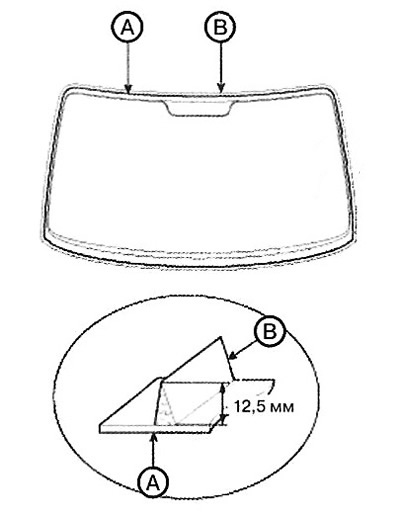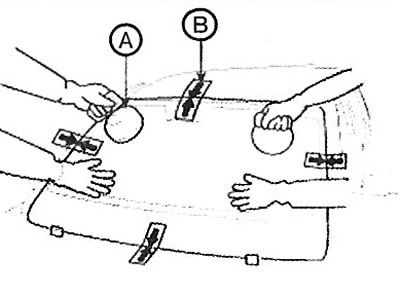
1. Windshield molding
2. Windshield
Withdrawal
Note: To prevent damage to the cladding when using a flat-blade screwdriver as a lever, wrap the screwdriver with electrical tape. Tape also adjacent parts that require protection. Wear gloves to protect your hands from injury.
1. Remove the following parts:
A. A-pillar trim.
B. Interior rearview mirror.
C. Rain sensor.
D. Wiper arm.
E. Hood cross member top cover.
F. Windshield defroster connector.
2. Remove molding (A) windshield with a screwdriver or a special puller.

3. Cut off the sealant with a special tool (A) (09861-31100).

4. Carefully remove the windshield (IN), using glass holders (A).

Installation
1. Using a knife, smooth out the layer of old adhesive on the seating surface of the entire windshield to a thickness of approximately 2 mm.
Attention.
It is not allowed to cut off the glue to the painted surface of the body, damage to the paintwork will interfere with normal gluing.
Remove the rubber seal with fasteners from the body.
Cover all surrounding surfaces before applying the compound.
2. Clean the seating surface with an alcohol-soaked sponge. After that, do not allow oil, grease and water to come into contact with the cleaned surface.
3. Install the upper part of the windshield seal (A) with fasteners. Avoid gaps.

4. Install the spacer and temporarily attach the windshield (IN). Align the glass to the center of the opening and draw a marking line.

5. Using a sponge, apply a thin coat of body primer to the old adhesive remaining around the windshield opening. Leave it on for at least 10 minutes to dry:
Attention.
Do not apply a glass primer to the body, be careful not to confuse sponges with different primers.
Never touch the primed surface with your hands.
Before applying the compositions to the window opening, close the dashboard of the passenger compartment.

6. Apply a light coat of glass primer to the outer surface of the retainers.
Note:
Do not touch the primed surface with your hand. Otherwise, the adhesive may not adhere properly to the glass, resulting in water leakage after the windshield is installed.
Do not apply body primer to the glass.
Keep water, dust and abrasive materials away from the primer.

7. Load the adhesive into the cartridge, being careful not to allow air pockets to form, which could interfere with the even distribution of the adhesive. Put the cartridge into the glue gun and apply a strip (A) glue on glass edges (IN) between the fasteners and the molding, as shown in the figure. Apply the adhesive no later than 30 minutes after applying the glass primer. In the corners, a strip of glue should be made a little thicker.

8. Holding the glass over the opening with glass holders (A), align it with the marking line (IN), applied in step 4 and place on the adhesive. Press lightly on the glass until its edges press the adhesive all the way around. Do not open or close the doors until the adhesive has dried.

9. Remove excess adhesive with a spatula or wipe off with a piece of cloth. Use a piece of soft cloth soaked in alcohol to remove adhesive from a painted surface or windshield.
10. Wait for the glue to dry (at least one hour), then pour water over the windshield and check for leaks. If a leak is detected, the damaged area must be thoroughly dried and then sealed with a sealant:
A. After installing the windshield, do not use the vehicle for at least four hours. If during this time it is necessary to use the car, you should move at low speed.
B. The windshield must remain dry for the first hour after installation.
11. Reinstall all removed parts. After the adhesive has dried thoroughly, install the rear view mirror. Advise the client not to do the following for three days:
A. Slam doors when all vehicle windows are closed.
B. Expose the body to strong shaking (e.g. when the vehicle is tilted or driving on a rough road).
12. Install the following items:
A. A-pillar trim.
B. Interior rearview mirror.
C. Rain sensor.
D. Wiper arm.
E. Hood cross member top cover.
F. Windshield defroster connector.
